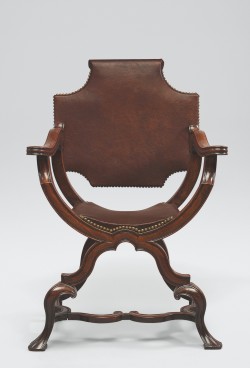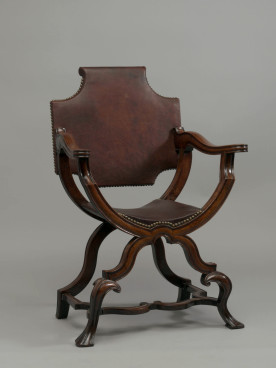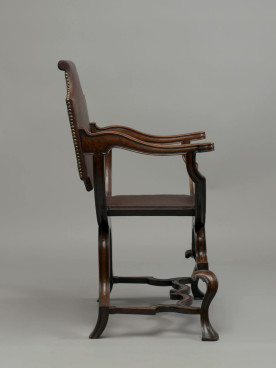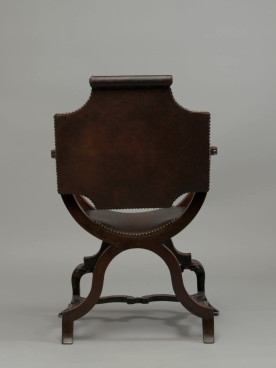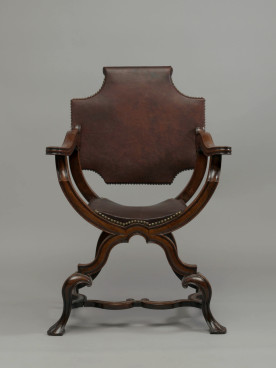Armchair, c.1715–30
Walnut, now with 18th-century Russia leather
This X-frame chair was once owned by the English writer and lexicographer Samuel Johnson (1709–1784).
Adam Bowett Catalogue (19/08/2012)
Description
An X-frame dressing chair, c. 1715. The escutcheon-shaped back and dished seat are covered with floral needlework. The whole frame is lightly moulded with a convex section edge with a continuous bead to each side.The downswept arms have rounded terminals. The X frame forms a U-shaped cradle for the seat, descending to cabriole forelegs with splayed feet, joined by a scrolling stretcher to the raked back heels.
Dimensions
H: 38 ¾ ” (99cm) Seat height: 17 ½ “ (44cm) W: 26 ½ ” (67cm) D: 22” (56cm)
Materials
Walnut, beech, various upholstery fabrics.
Dating criteria
The X frame is an ancient European seating form but this particular variant seems to have developed at the beginning of the eighteenth century. In particular, the scrolled top to the back and the early form of cabriole leg suggests a date of 1715 to 1720, which is consistent with the design of the stretcher. A modified version of the leg and stretcher designs is shown in a portrait of Arthur Vansittart, painted by Michael Dahl in 1718. This is at Lyme Park, Cheshire.
Construction
The chair is conceived as two front and back Xs connected horizontally by the arms, the seat rails, and the side stretchers. Each X is composed of two S’s half-lapped at the crossing. The lower section of the front frame is pieced and shaped to create the cabriole leg. The stretcher is conventionally constructed in three parts and tenoned at all points. The arms are tenoned (?) into the back and mortised onto tenons on the front and back frames. Construction of the back is conjectural because fully upholstered, but the seat is simply a webbed cloth pad supported by two beech side rails to which the webbing and upholstery is attached. These rails are tenoned fore and aft into the front and back frames.
Condition
The upholstery is not original and was installed in the 1990s. The frame has been extensively cleaned, with virtually all patination removed. There have been significant repairs to the X frames front and back, where metal plates were applied to the crossings (now removed), also to the lower portions of both front and back feet such that it is difficult to establish which timber is original and which replaced. There have been breaks and repairs to the left side stretcher and the joint between the right side stretcher and medial stretcher has been repaired with a plugged screw. However, given the complexity of the design and its inherent weakness the condition is remarkably good.
Additional remarks
This is one of the earliest and most elaborate forms of what has now been identified as a dressing chair. The design is discussed in Wood (2008), I, pp. 38-40. Later variants eschewed the X frame in favour of more conventional forms (see Cat no. 2). A detail of the Vansittart portrait showing the leg and stretcher design is shown in Bowett (2009), pl. 4.39. A chair of almost identical form is shown in a watercolour by W.H. Pyne, published c.1820, of Queen Mary’s State Bedchamber at Hampton Court Palace.
References
Lucy Wood, Upholstered Furniture in the Lady Lever Art Gallery, 2 Vols., New Haven and London (2008), I, pp. 38-40, figs. 47&48.
Provenance
Purchased Hotspur January 1995.
Collection of David McAlpine.
Christie’s London. 12th July 1928, lot 86.
By repute, Dr. Samuel Johnson (1709-1784)

